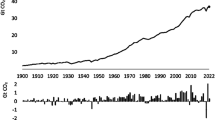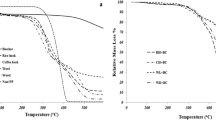Abstract
A composite biomass insulation material, which uses geopolymers as adhesives and forestry waste as fillers, was proposed and experimentally tested. The orthogonal experimental method was adopted to analyze the optimum theoretical oxide molar ratios and the mass ratio of mixing water to binder (mw2/mB) for preparing geopolymers. The influences of curing regimes (including one-stage and two-stage curing methods) and mw2/mB ratios of the insulation materials on mechanical, thermal, and hydraulic performances were also studied by experiment. The results indicated that the optimum combination scheme of preparing geopolymers was molar ratio \(x_{\rm{SiO}_2}/x_{\rm{Na}_2{O}}=3.3\), \(x_{\rm{SiO}_2}/x_{\rm{Al}_2{O}_3}=3.2\) and mw2/mB =0.5 with the highest mechanical strength of 34.21 MPa. Besides, the best curing conditions of the composite material were the curing temperatures of 85°C and 70°C under the two-stage curing regime, which could achieve the low heat conductivity of 0.123 and 0.125 W/(m·K), and the high mechanical strength of 1.70 MPa and 1.71 MPa, respectively. The optimum mw2/mB ratios of the biomass material were 0.5 to 0.55 with heat conductivity of 0.114 to 0.125 W/(m·K). This novel composite insulation material has satisfying physical performances, which is helpful for achieving building energy conservation.
Similar content being viewed by others
Abbreviations
- KX m :
-
sum value of the experimental results which contains the factors with m level
- kX m :
-
mean value of experimental results containing m-level factors
- R:
-
distance between extreme values of KXm and kXm
- F:
-
surfactant
- H:
-
H2O2 solution
- S:
-
sawdust
- w1:
-
mixing water added into the soluble silicate solution to make the alkali activator
- w2:
-
mixing water contained in the adhesive
- w3:
-
wetting water of the sawdust
References
Chen B., Xiong R., Li H.L., Sun Q., Yang J., Pathways for sustainable energy transition. Journal of Cleaner Production, 2019, 228: 1564–1571.
Xing Q.W., Hao X.L., Lin Y.L., Tan H., Yang K., Experimental investigation on the thermal performance of a vertical greening system with green roof in wet and cold climates during winter. Energy and Buildings, 2019, 183: 105–117.
Kang S.S., Li H.Q., Liu L.F., Zeng R., Zhang G.Q., Evaluation of a novel coupling system for various load conditions under different operating strategies. Energy Conversion and Management, 2016, 109: 40–50.
Papadopoulos A.M., Giama E., Environmental performance evaluation of thermal insulation materials and its impact on the building. Building and Environment, 2007, 42: 2178–2187.
Hidalgo J.P., Welch S., Torero J.L., Performance criteria for the fire safe use of thermal insulation in buildings. Construction and Building Materials, 2015, 100: 285–297.
Cai S.S., Zhang B.X., Cremaschi L., Review of moisture behavior and thermal performance of polystyrene insulation in building applications. Building and Environment, 2017, 123: 50–65.
Menyhart K., Krarti M., Potential energy savings from deployment of dynamic insulation materials for US residential buildings. Building and Environment, 2017, 114: 203–218.
Liu L.F., Li H.Q., Andrea L., Giovanni M., Tong C.Y., Liu Q.B., Li N.P., The development history and prospects of biomass insulation materials for buildings. Renewable & Sustainable Energy Reviews, 2017, 69: 912–932.
Dhakal U., Berardi U., Gorgolewski M., Richman R., Hygrothermal performance of hempcrete for Ontario (Canada) buildings. Journal of Cleaner Production, 2017, 142: 3655–3664.
Paiva A., Pereira S., Sá A., Cruz D., Varum H., Pinto J., A contribution to the thermal insulation performance characterization of corn cob particleboards. Energy and Buildings, 2012, 45: 274–279.
Shea A., Wall K., Walker P., Evaluation of the thermal performance of an innovative prefabricated natural plant fibre building system. Building Services Engineering Research and Technology, 2013, 34: 369–380.
Korjenic A., Zachb J., Hroudová J., The use of insulating materials based on natural fibers in combination with plant facades in building constructions. Energy and Buildings, 2016, 116: 45–58.
Liu L.F., Zou S., Li H.Q., Deng L., Bai C.Y., Zhang X.F., Wang S., Li N.P., Experimental physical properties of an eco-friendly biomass insulation material based on wheat straw for buildings. Energy and Buildings, 2019, 201: 19–36.
Sierra-Perez J., Boschmonart-Rives J., Dias A.C., Gabarrell X., Environmental implications of the use of agglomerated cork as thermal insulation in buildings. Journal of Cleaner Production, 2016, 126: 97–107.
Lakrafli H., Tahiri S., Albizane A., Houssaini S.E., Bouhria M., Effect of thermal insulation using leather and carpentry wastes on thermal comfort and energy consumption in a residential building. Energy Efficiency, 2017, 10: 1189–1199.
China Forestry and Grassland Bureau. 2017 China forestry statistical yearbook. China Forestry Publishing House, 2018, ISBN: 9787503897337. (In Chinese)
Slawomir G., Karol W., Influence of biomass co-combustion on heating surfaces thermal efficiency. Journal of Thermal Science, 2018, 27: 427–432.
Rahbar K., Mahmoud S., Al-Dadah R.K., Moazami N., Ashmore D., Feasibility study of power generation through waste heat recovery of wood burning stove using the ORC technology. Sustainable Cities and Society, 2017, 35: 594–614.
Turku I., Kärki T., Accelerated weathering of fire-retarded wood–polypropylene composites. Composites Part A: Applied Science and Manufacturing, 2016, 81: 305–312.
Bütün F.Y., Sauerbier P., Militz H., Mai C., The effect of fibreboard (MDF) disintegration technique on wood polymer composites (WPC) produced with recovered wood particles, Composites Part A: Applied Science and Manufacturing, 2019, 118: 312–316.
Davidovits J., Geopolymers and geopolymeric materials. Journal of Thermal Analysis and Calorimetry, 1989, 35: 429–441.
Bai C.Y., Colombo P., Processing, properties and applications of highly porous geopolymers: A review. Ceramics International, 2018, 44: 16103–16118.
Samal S., Thanh N.P., Marvalova B., Petrikova I., Thermal characterization of metakaolin-based geopolymer. The Minerals, Metals & Materials Society, 2017, 69: 2480–2484.
Van Jaarsveld J.G.S., Van Deventer J.S.J., Lukey G.C., The effect of composition and temperature on the properties of fly ash- and kaolinite-based geopolymers. Chemical Engineering Journal, 2002, 89: 63–73.
Lahoti M., Yang E.H., Tan K.H., Influence of mix design parameters on geopolymer mechanical properties and microstructure. Developments in Strategic Ceramic Materials II: Ceramic Engineering and Science Proceedings, 2017, 37: 21–33.
Liu Z., Shao N.N., Wang D.M., Qin J.F., Huang T.Y., Song W., Lin M.X., Yuan J.S., Wang Z., Fabrication and properties of foam geopolymer using circulating fluidized bed combustion fly ash. International Journal of Minerals, Metallurgy and Materials, 2014, 21: 89–94.
Provis J.L., Van Deventer J.S.J., Direct measurement of the kinetics of geopolymerisation by in-situ energy dispersive X-ray diffractometry. Journal of Materials Science, 2007, 42: 2974–2981.
Vaou V., Panias D., Thermal insulating foamy geopolymers from perlite. Minerals Engineering, 2010, 23: 1146–1151.
Masi G.M., Rickard W.D.A., Vickers L., Bignozzi M.C., Van Riessen A., A comparison between different foaming methods for the synthesis of light weight geopolymers. Ceramics International, 2014, 40: 13891–13902.
Muñiz-Villarreal M., Manzano-Ramírez A., Sampieri-Bulbarela S., Gasca-Tirado J.R., Reyes-Araiza J.L., Rubio-Ávalos J.C., Pérez-Bueno J., Apatiga L., Zaldivar-Cadena A., Amigó-Borrás V., The effect of temperature on the geopolymerization process of a metakaolin-based geopolymer. Materials Letters, 2011, 65: 995–998.
Bai C.Y., Colombo P., High-porosity geopolymer membrane supports by peroxide route with the addition of egg white as surfactant. Ceramics International, 2017, 43: 2267–2273.
Bai C.Y., Franchin G., Elsayed H., Zaggia A., Conte L., Li H.Q., Colombo P., High-porosity geopolymer foams with tailored porosity for thermal insulation and wastewater treatment. Journal of Materials Research, 2017, 32: 3251–3259.
Wang B.H., Jin Y., Luo Y.G., Parametric optimization of EQ6110HEV hybrid electric bus based on orthogonal experiment design. International Journal of Automotive Technology, 2010, 11: 119–125.
Lahoti M., Wong K.K., Yang E.H., Tan K.H., Effects of Si/Al molar ratio on strength endurance and volume stability of metakaolin geopolymers subject to elevated temperature. Ceramics International, 2018, 44: 5726–5734.
Komnitsas K., Zaharaki D., Geopolymerisation: A review and prospects for the minerals industry. Minerals Engineering, 2007, 20: 1261–1277.
Gao X.S., Zhang Y.D., Zhang H.W., Wu Q., Effects of machine tool configuration on its dynamics based on orthogonal experiment method. Chinese Journal of Aeronautics, 2012, 25: 285–291.
Zou G.L., Xu J., Wu C., Evaluation of factors that affect rutting resistance of asphalt mixes by orthogonal experiment design. International Journal of Pavement Research and Technology, 2017, 10: 282–288.
Alomayri T., Shaikh F.U.A., Low I.M., Characterisation of cotton fibre-reinforced geopolymer composites. Composites Part B: Engineering, 2013, 50: 1–6.
Chikhi M., Agoudjil B., Boudenne A., Gherabli A., Experimental investigation of new biocomposite with low cost for thermal insulation. Energy and Buildings, 2013, 66: 267–273.
Zou S., Li H.Q., Wang S., Jiang R.H., Zou J., Zhang X.F., Liu L.F., Zhang G.Q., Experimental research on an innovative sawdust biomass-based insulation material for buildings. Journal of Cleaner Production, 2020, 260: 121029.
Singh P.S., Bastow T., Trigg M., Structural studies of geopolymers by 29Si and 27Al MAS-NMR. Journal of Materials Science, 2005, 40: 3951–3961.
Lin T.S., Jia D.C., He P.G., Wang M.R., Thermalmechanical properties of short carbon fiber reinforced geopolymer matrix composites subjected to thermal load. Journal of Central South University of Technology, 2009, 16: 881–886.
Acknowledgments
This study was funded by the Science and Technology Bureau of Changsha, China (No. kh1902239) and National Natural Science Foundations of China (No. 52076070; No. 52008166).
Author information
Authors and Affiliations
Corresponding author
Rights and permissions
About this article
Cite this article
Li, H., Zou, S., Liu, T. et al. Research on a Composite Biomass Insulation Material with Geopolymers as Binders and Forestry Waste as Fillers. J. Therm. Sci. 31, 590–605 (2022). https://doi.org/10.1007/s11630-020-1387-y
Received:
Published:
Issue Date:
DOI: https://doi.org/10.1007/s11630-020-1387-y




